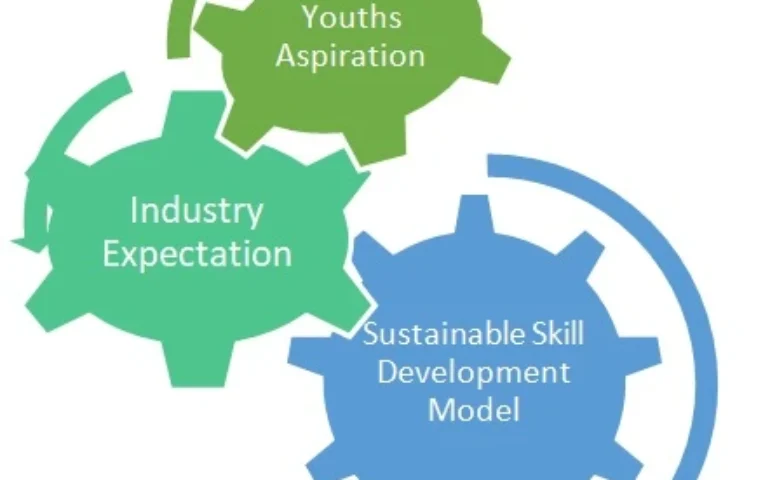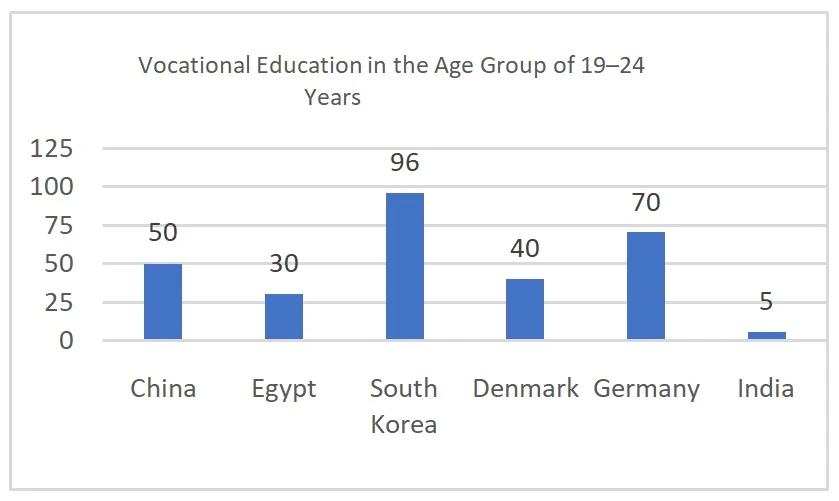
Skill development of the youths entering into workforce is the central pillar of the nation’s economic growth and social development. India is facing dual challenge of employability and employment. Only 5% of India’s workforce in the age group of 19-24 has received any formal vocational education. While only 10.8% of India’s total workforce has undergone any kind of skill training program in comparison of 60- 90% skilled workforce in developed economy.[1] On the other hand, the youth unemployment rate for the year 2019 was 23.34%, is the highest in the last few years.[2
Sinces kill development issue is pertinent at both demand and supply side so both sides should get equal focus while designing a sustainable skilling model for youths.
The present paper has discussed the challenges

Vocational Education in the Age Group of 19-24 Years associated with the supply-side of skill development predominantly for youths entering into the workforce and various aspects of vocationalization of school education with respect to new education policy-2020. There are several Non-government Organizations (NGOs) and philanthropic institutions that has created a cadre of youths, enabled with vocational skills in partnership with different stakeholders in various parts of the country. Their grassroots experiences have been also covered in the present paper.
Challenges Associated with Skills Development:
Various challenges are associated with skill development in India, one of them is mobilization of youths to get trained, and several other causal factors are also associated with the low enrollment of the youths in vocational education. Foremost, before New Education Policy (NEP)NEP, vocational education was only designed for higher secondary students or drop out students in grade 8 and upward. Secondly, lack of a well-defined higher education path in the chosen vocational field, and almost no mobility in mainstream education. In general, it is observed that vocational education is considered inferior compared to mainstream education and considered primarily designed for the students unable to cope with mainstream education.

There is a severe mismatch between industry expectations and job ambition of the youths. A study conducted by E&Y in Uttarakhand on youth’s aspiration shows that the majority of the youths aspire to join manufacturing, construction, tourism, health care, automobiles, and food processing industries. In contrast, industry demand for the workforce is more for agriculture & allied services, real estate, and health care.[3] Similarly, Punjab’s construction sector has high employment opportunities, and a skilled workforce is required, but there is a dismal supply of skill human resources. Lack of synergy between industry expectation and youth aspiration creates a vicious cycle of a flawed skilling model. Poor alignment leads to weak association with government, industries, and training institutions. It also limits funding by industries on upgrading the existing course curriculum and trainer’s training, that hamper the whole skill development ecosystem.
There is a severe shortage of experienced trainers in skill institutes. As perDirectorate General of Employment & Training (DGE&T) field institutes are running under low capacities. Nearly 60-70% of positions of trainers are vacant in such skill institutes.[4] Currently, DGE&T field institutes are producing only 2000 trained trainers annually while demand is of 20,000 trainers.[5]
Women labour force participation rate in India is only 27% compared to 79% for males.[6] Lack of some of the foundational skills, stringent social norms are some of the factors that contribute to a low rate of women work participation. The Annual Status of Education Report (ASER) 2018 depicts a dismal picture of girls’ fundamental skills during school education. According to ASER report, “less than 30% of girls aged 14-18 in rural India can calculate simple percentages, compared to nearly 50% of boys in the same age group”.[7]Shagun Sabarwal, associate director of policy and training, J-PAL South Asia suggests, “dedicated efforts to draw young women into the labour force and equip them with the right skills outside the formal education system is the need of the hour”.[8]
Inadequate training infrastructure at sourcing clusters is a significant challenge in skill development. People migrate from rural to urban for better livelihoods opportunity. For example, Districts of Pouri, Garhwal, Bageshwar, Chamoli, and Tehri Garhwal of Uttarakhand have the highest migration rate from rural and urban areas.[9]Most of the migrants who seek entry-level jobs are unskilled. The high cost of living in the cities, coupled with a new environment, deter them from taking up training. Various NGOs had put resources and developed skilling model for youths at sourcing clusters in remote locations in different parts of the country. One such organization ‘An Association for Development Harmony and Action Research’(AADHAAR) is implementing a digital literacy programe in collaboration with CSC Academy funded by Capgemini. Under this program, AADHAAR envisioned to train one lakh candidates on digital literacy & English-speaking course across 11 Cities in urban /semi-urban areas empowering children from low-income communities so that youths can access opportunities for growth and well-being for self, family, and society at large. Similarly, AADHAAR is developing women entrepreneurs through Silai School Model.
Strong collaboration among government, industries, philanthropic organizations, and training institutes is required in the area of finance, bringing knowledge, technology and capacity building for creating a scalable skilling model at sourcing clusters.
Reimagining Vocational Education
A plethora of policy initiatives has been proposed under the title ‘Reimagining vocational education’ in new education policy. A major emphasis has been given on introducing vocational and polytechnic education for school students, aiming to remove the rigid separation between academic and vocational streams. Under this initiative, students will be exposed to vocational education courses during school days and they will have freedom of upward mobility in the same or mainstream education. The introduction of vocational training to the students during school will provide a platform for an informed choice to the youths for their higher vocational degrees based on their interests. The policy encourages 10 ‘Bagless’ days throughout the year for various enrichment activities involving arts, quizzes, sports, and vocational crafts.[10] It will work as a catalyst for developing innate talents in young mind. On the other hand, we can’t ignore the unintended consequences of the vocationalization of education in early school days. As someexperts has opinion that vocationalization of early school education may lead to distraction in primary schooling and it may create a hindrance for first-generation learners, especially those from a marginalized section of the society[11].
Way Forward
Industry oriented training is closely linked to the right form of training delivered by trainers. NEP advocates the formation of The National Skills Qualifications Framework. This quality assurance framework will create a benchmark of Indian standards aligned with the International standard of skill education. Currently, 20 million children are out of mainstream education. Various ways have been proposed i.e. vocational courses, adult literacy, life-enrichment programs and national and state open schools to bring them in mainstream education. Robust planning and inter-departmental coordination are required to get the desired result in the coming future. The employable skill set cannot be achieved unless we meet the urgent requirement of experienced qualified trainers. The well-structured career path of industry workers would be a motivating factor for becoming skilled trainers. At the same time, policymakers should focus on creating an industry-oriented trainers’ training ecosystem.
AADHAAR- An Association for Development, Harmony and Action Research came into a formal existence on Jan 29th, 2011 as a nationally registered not for profit organization. AADHAAR believes that only strong models of community engagement could bring necessary changes at the grassroots and can be point of references for policy advocacy Vision: AADHAAR envisions an empowered, informed and just society Mission: AADHAAR support and strengthen grassroots action and civil society; to advocate and promote policies and institutions for sustainable development and inclusion of the marginalized
References:
[1]https://corporate.cyrilamarchandblogs.com/2020/09/nep-2020-vocational-education-fuel-for-the-indian-demographic-dividend/#_ftn3
[2]https://www.macrotrends.net/countries/IND/india/youth-unemployment-rate
[3] District wise skill gap study for the state of Uttarakhand (2017, 2022), NSDC
[4] Re-engineering the skill ecosystem, KPMG, and FICCI, Sept 2016
[5] ibid
[6]https://www.aljazeera.com/features/2019/05/21/as-india-grows-why-are-fewer-women-finding-employment/
[7]Sabarwal, S. (2018, March 19). Young women hold the key to skilling India. Retrieved from http://web.archive.org/web/20190714043635/https://www.hindustantimes.com/analysis/young-women-hold-the-key-to-skilling-india/story-G02idBk4AYYgebebCf2jKJ.html
[8] Ibid
[9]VisthapitJanasankhyaSarvekshan’ for 2011-12 with Directorate of Economic and Census
[10] https://www.ndtv.com/education/new-education-policy-bagless-days-be-encouraged-in-schools
[11]https://www.thehindu.com/news/national/tamil-nadu/vocational-courses-may-distract-poor-students/article32244096.ece
3 Replies to "Strengthening Vocational Education in India"
Mark Smith
Lorem ipsum is simply dummy text of the printing and typesetting industry. Lorem Ipsum has been the industry’s standard dummy text ever the printing and typesetting industry. Lorem Ipsum has been the industry’s standard dummy text since the 1500s.
Mark Smith
Lorem ipsum is simply dummy text of the printing and typesetting industry. Lorem Ipsum has been the industry’s standard dummy text ever the printing and typesetting industry. Lorem Ipsum has been the industry’s standard dummy text since the 1500s..
Mark Smith
Lorem ipsum is simply dummy text of the printing and typesetting industry. Lorem Ipsum has been the industry’s standard dummy text ever the printing and typesetting industry. Lorem Ipsum has been the industry’s standard dummy text since the 1500.